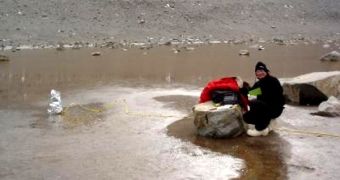One of the most interesting traits water has is the fact that its freezing point drops considerably depending on its salinity. In other words, the higher the salt concentration, the lower the temperature needed to freeze the brine. One of the best places in the world to study this is the Don Juan Pond, a lake located in the Dry Valleys of Antarctica. Though very shallow, the waters here are more than 18 times saltier than in ocean, which means that they never freeze, even when exposed to temperatures as low as minus 40 degrees Fahrenheit.
Researchers working at this location say that the pond may be used as a proxy for studying similar formation on our closest neighboring planet, Mars. Conditions such as the ones in the Dry Valleys may exist on the Red Planet as well, astrobiologists say, and gaining a deeper understanding of how water behaves in such saline concentrations, as well as what gases are produced, could help the quest for life on Mars. While investigating the Don Juan Pond, US scientists from the University of Georgia managed to stumble upon a previously-unreported mechanism of producing nitrous oxide, more commonly known as laughing gas.
The substance is a very potent greenhouse gas, right alongside carbon dioxide and methane. “The pond's soils and brines and the surrounding rock types are similar to those found on Mars. So it provides an ideal location to assess microbial activity in extreme environments. While we did not detect any 'bio-gases' such as hydrogen sulfide and methane, we did, surprisingly, measure high concentrations of nitrous oxide, which is normally an indicator of microbial activity,” says UG Franklin College of Arts and Sciences Department of Marine Sciences faculty member Samantha Joye.
“We needed to find out whether a non-organic process could account for this nitrous oxide production,” adds the expert, who was also the lead author of a new paper detailing the findings. The work was published in the April 25 issue of the esteemed scientific journal Nature Geoscience. The investigators hope to be able to use the new knowledge to develop more advanced sensors, that could easily detect conditions similar to the ones here on other planets or moons. Funding for the new study was obtained through the US National Science Foundation (NSF) Antarctic Organisms and Ecosystems program and the McMurdo Microbial Observatory program.
"What we found was a suite of brine-rock reactions that generates a variety of products, including nitrous oxide and hydrogen. In addition to Don Juan Pond, this novel mechanism may occur in other environments on Earth as well and could serve as both an important component of the Martian nitrogen cycle and a source of fuel [hydrogen] to support microbial chemosynthesis,” Joye adds, quoted by ScienceDaily.

 14 DAY TRIAL //
14 DAY TRIAL //